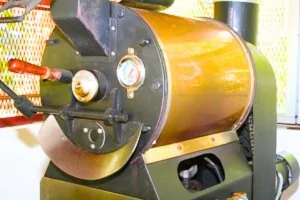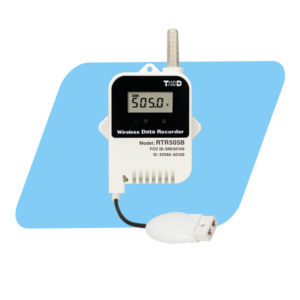
This article explores how a small coffee roaster utilized wireless temperature monitoring to achieve consistent, high-quality coffee roasts.
The Challenge: Achieving Consistent Flavor
Creating unique coffee flavors involves experimenting with green coffee beans roasted at precise temperatures. Traditionally, this required trial and error with an industrial roaster set to a base temperature (around 220°C for a city roast). The roaster needed a user-friendly and affordable way to monitor temperature wirelessly with alarms to ensure consistent results.
The Solution: Wireless Temperature Monitoring
 CAS DataLoggers provided a solution with the T&D RTR-505B-TC Wireless Thermocouple Data Logger. This device was installed near the roaster and connected to a heat-resistant probe placed directly within the coffee roasting beans. The probe continuously monitored high temperatures, transmitting data wirelessly to a nearby T&D RTR-500 Wireless Base Station. The data logger’s display provided real-time temperature readings, allowing the roaster to maintain consistent coffee bean roasting.
CAS DataLoggers provided a solution with the T&D RTR-505B-TC Wireless Thermocouple Data Logger. This device was installed near the roaster and connected to a heat-resistant probe placed directly within the coffee roasting beans. The probe continuously monitored high temperatures, transmitting data wirelessly to a nearby T&D RTR-500 Wireless Base Station. The data logger’s display provided real-time temperature readings, allowing the roaster to maintain consistent coffee bean roasting.
Benefits of Wireless Monitoring
- Alarm System: The data logger featured customizable alarms that alerted the roaster if the temperature deviated from the desired coffee roasting profile.
- Data Recording and Storage: The system measured, stored, and wirelessly transmitted temperature data to the base station at set intervals. The data logger’s memory could hold up to 16,000 readings – a substantial amount of roasting information.
- Compact and User-Friendly: The data logger’s small size allowed for easy placement on the roasting machine. Additionally, user-friendly software facilitated a smooth setup process.
- Wireless Data Transfer: After roasting, the data logger wirelessly transmitted information to the base station, even from distances of up to 500 feet indoors. The data could then be downloaded to a computer in just 2 minutes for further analysis. This wireless capability allowed for remote monitoring of current and historical data, which could be displayed in graphs or exported for further use.
Overall Impact
The wireless temperature monitoring system significantly improved the roaster’s workflow. He could now effectively monitor the roasting process, document temperature profiles, and replicate them for consistent results. The user-friendly interface and affordable price made this system an ideal solution for his small business.
For more information on the T&D RTR Wireless Data Loggers, or to find the ideal solution for your application-specific needs, contact a CAS Data Logger Applications Specialist at (800) 956-4437 or request more information.

